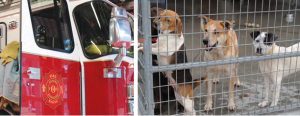Criminal Justice Students Foster Community Connections
Mississippi has one of the highest adult incarceration rates in the nation. The Pew Charitable Trusts has reported that the prison population in the state has grown by over 300% during the past three decades, a rate that far outstrips Mississippi’s rate of population growth. According to the Sentencing Project, blacks in Mississippi are incarcerated at a rate that is 3.5 times higher than whites.
The corrections system is by nature isolated from the fabric of social institutions in the wider community. Future criminal justice practitioners in CJ 390: Service- Learning in Criminal Justice had the opportunity to bridge that gap by exploring their role as individuals while volunteering with several community organizations in Oxford and Lafayette County.
Associate Professor of Legal Studies, Dr. Linda Keena, created this course because of her conviction that service-learning can be especially beneficial for studying criminal justice. “Service-learning may be more important in criminal justice than other areas of study because it connects classroom learning to the real-life criminal justice system,” she explained. “Service in all three subsystems – fire/police, courts, and corrections – encourages students to question their preconceptions, examine their assumptions, observe the connectedness of community partners, and gain vital field experience.”

Service-learning experiences prepare criminal justice students to be effective practitioners by challenging classroom concepts with real-world experience.
Students in CJ 390 completed a minimum of 25 service hours at various nonprofit organizations, including the American Red Cross, Boys and Girls Club, Family Exchange Center, Mississippi State Veterans Home, Oxford-Lafayette Humane Society, and the Oxford Fire Department. While each of these organizations addresses a different community need, the class came together to share observations and reflections on the interconnectedness of these institutions in serving the broader Oxford-Lafayette County community.
As they engaged with these community organizations, students gained an appreciation of the extent to which nonprofit organizations depend on volunteers and financial donations. In her final paper, one student wrote: “I never understood how much effort it took to run a humane society, and I was completely unaware that they were nonprofit; they function solely from volunteers and donations.” This observation was echoed by students who served at various community organizations.
One of the course objectives was to open students’ eyes to the diversity that exists in society, and how this impacts community needs and solutions. One student who completed his service-learning hours with the Oxford Fire Department observed the following: “I didn’t know there were so many people experiencing poverty, especially in Oxford. The firefighters told me that the low-income people are really subjected to more fires because they can’t afford safe heating and air conditioning. They live in trailer homes that burn fast and drive vehicles that are so damaged they burn quicker.” In reflecting on poverty and race in his community, this student wrote, “I’m glad the fire department is professional. It doesn’t discriminate between affluent people and those who aren’t, or the blacks and the whites.”
New criminology research suggests that growing income inequality in the United States is linked to public policies that have resulted in mass incarceration. It is imperative, then, that students of criminal justice develop a nuanced understanding of the social forces that result in intergenerational poverty, and how incarceration relates to social mobility.
One student mentored juveniles participating in the Adolescent Offender Program with the Family Exchange Center. Throughout the course, the student worked to break down barriers with the youth as he simultaneously grappled with his own preconceived notions of youth in the correctional system. “I noticed, too, that my attitude towards the juvenile had changed,” he wrote. “I no longer thought of the juveniles as bad, evil criminals. Instead, I saw them as troubled kids.”
Much of this learning stems from the emphasis on reflection in the service-learning course design. As they progressed through the course, students were prompted to record their evolving thought processes on their service experience, intellectual inquiry, and personal beliefs. In the final paper, one student shared: “Reflection played a big role in my service-learning project. I did not realize my growth while completing the project until I read over my reflections…if it was not for the reflection process, I would have never seen my growth.” These regular reflection journals and prompts served as a yardstick for students to measure their evolution throughout the course. This can be a powerful exercise, particularly when students move outside their comfort zone.
Another dimension of the reflection process allowed students to gain insights about their desired for me. My last day at the center, I knew I wanted to continue to work with the juveniles. I felt a sense of accomplishment being there.”
“My students really benefited from the course,” remarked Dr. Keena. “They got to witness authentic criminal processes and practices. The field experience required them to take ownership of their own learning, by challenging them to reflect on their misconceptions and predetermined attitudes. Participating students were able to form their own conclusions based on the realities they witnessed rather than media or biased reports.”
In addition, the community partners benefited from the service learners. Fred Johnson, Executive Director of the Family Exchange Center, noted that “the students were so valuable because we used them to provide much-needed programming to the offenders.” Staff at the Boys and Girls Club highlighted the mutually beneficial exchange of knowledge in reflecting that “we learned as much from the students as they learned from us.”
Through the service-learning experience, students honed their skills as future criminal justice practitioners both in and out of the classroom. The students felt connected not only to the youth and the staff, but also to the broader community. This can combat the perception that college students are isolated from the community at large, while providing much-needed support to under-resourced community organizations.
For more information about CJ 390, contact Dr. Linda Keena at (662) 915-1998 or ldkeena@olemiss.edu.